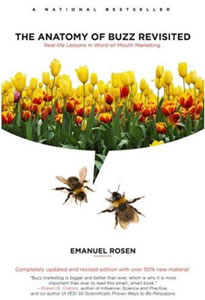Everyone is looking for buzz – people talking about their offering. We all know that word of mouth marketing is the strongest form of marketing: it’s free, it spreads, and it’s personal. But how can you get your message to be spread virally?
Emanuel Rosen has been studying buzz for over 10 years (the accidental, the intentional, and the incorrect) and has amassed a lot of rules/tips to help you increase your “buzz factor”.
Today, the common advice you’re given is: go on a social media site (such as Facebook or Twitter), befriend a lot of people, join their conversation, and tell your story. The hope is that by sheer numbers, your story/message will go viral. The problem is, that advice only works if: your message is viral-friendly and if you have the right audience.
Is your message viral-friendly? People tend to talk about exciting products, innovations, personal experiences/interactions, complex products (that take an expert to understand), expensive products (to validate the price/value ratio), and visible products (things that they see in their environment). We are programmed to talk with each other, and we’re always looking to connect our lives with others’. A viral-friendly message is something that would naturally occur in our day-to-day interactions and whose purpose is to establish a positive social connection.
Do you have the right audience? The right audience may not be who you think they are. The the essence of any marketing strategy: identifying your target market to ensure you solve the problem they’re facing. Most people, after identifying their target market, try to target it with buzz directly. The problem is, not everyone that’s reachable is listening to you (an unknown or someone with a vested interest in the message). Instead of trying to try to target everyone – target the influencers. In the past, the influencers were editors/writers of newspapers and magazines. While these people are still influencers, there are now a large number of other people (“network hubs”) that are listening for something new/interesting to share with “their people”. It may be their Twitter followers, their blog readers, the eNewsletter subscribers, or their social group.
All network hubs share the following qualities: Ahead in adoption, Connected, Travelers, Information-hungry, Vocal, and Exposed to the media more than others (ACTIVE is the acronym). The book focuses on how to find such hubs:
- Letting network hubs identify themselves
- Identifying categories of network hubs
- Spotting network hubs in the field
- Identifying network hubs through surveys
Once you’ve identified the hubs, you need to give them something worth talking about and encouragement to share the message with others. And by all means, make sure that what they’re talking about is something of true value (otherwise, your buzz will turn negative on you).
If you’re interested in more information about buzz, you may also want to check out WOMMA.
